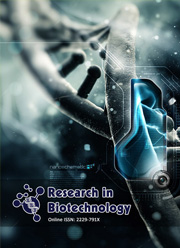Impact of two disinfectants on detachment of Enterococcus faecalis from polythene in aquatic microcosm
DOI:
https://doi.org/10.19071/rib.2016.v7.2981Abstract
After cell adhesion processes in microcosm, the impact of sodium hypochlorite (NaOCl) and hydrogen peroxide (H2O2) on the detachment of Enterococcus faecalis from polythene fragments immersed in water under stationary and dynamic conditions was assessed. The abundance of planktonic cells was also evaluated. The density of E. faecalis adhered in absence of disinfectant fluctuated between 2 and 4 units (Log CFU/cm2). After living in disinfected water, the density of E. faecalis remained adhered to polythene sometimes reached 2 units (Log CFU/Cm2). This highest abundance of cells remained adhered was recorded with cells coming from the lag, exponential and stationary growth phases in water treated with 0.5‰ NaOCl. In H2O2 disinfected water, the highest value was recorded at all cells growth phases with 5‰ H2O2 concentration. Adhered E. faecalis cells have been sometimes completely or partially decimated respectively by NaOCl and H2O2 treated water. Considering separately each experimental condition, it was noted that increasing the concentration of disinfectant caused a significant decrease (P≤0.01) in abundance of cells stay adhered after living in water disinfected by the two disinfectants. Changes in disinfectant concentrations in different experimental conditions had an impact on the detachment of E. faecalis cells from the substrates.Â
Downloads
References
Allion A. 2004. Environnement des bactéries et sensibilité aux biocides: Mise au point d’une technique rapide pour déterminer in situ l’efficacité des agents bactéricides. Thèse de Doctorat, École Nationale Supérieure Industries Agricoles et Alimentaires.
American Public Health Association (APHA), 2005. Standard Methods for the Examination of Water and Wastewater. American Public Health Association. Washington, DC, USA, 21st edition.
Beaupoil A, Le Borgne C, Moussa Atto A, Mucig C et Roux A. 2010. Risques sanitaires liés à la réutilisation d’eaux usées traitées pour l’aéroaspersion des espaces verts. Thèse, École des Hautes Études en Santé Publique.
Beech IB and Coutinho CLM. 2003. Biofilms on corroding materials, In Biofilms in Medicine, Industry and Environmental Biotechnology-Characteristics, Analysis and Control, Chapter 8. Edited by Lens P, Moran AP, Mahony T, Stoodley P and O’Flaherty V.
Beech IB and Sunner J. 2004. Biocorosion: Towards understanding interaction between biofilms and metals. Journal of Current Opinion in Biotechnology. 15:181-186.
Boutaleb N. 2007. Étude de la formation des biofilms sur les surfaces de matériaux couramment utilisés dans les canalisations d’eau potable. Thèse de Doctorat, Université de Bretagne-Sud.
Briandet R, Meylheuc T, Maher C and Bellon-Fontaine MN. 1999. Listeria monocytogenes Scott A: Cell Surface Charge, Hydropho-bicity, and Electron Donor and Acceptor Characteristics under Different Environ-mental Growth Conditions. Applied and Environmental Microbiology. 65:5328-5333.
Coeyrehourcq KL. 2003. Étude de méthodes rapides d’analyse de la structure moléculaire du polyéthylène. Thèse de Doctorat, École des Mines de Paris Spécialité Science et Génie des Matériaux.
Doggett MS. 2000. Characterization of fungal biofilms within a municipal water distribution system. Applied Environ-mental Microbiology. 66:1249-1251.
Dukam S, Pirion P, et Levi Y. 1995. Modélisation du développement des biomasses bactériennes libres et fixées en réseau de distribution d’eau potable. Dans : Adhésion des microorganismes aux surfaces. M.N. Bellon-Fontaine et J. Fourniat (éds), Paris, 149-160.
Gauthier Y et Isoard P. 1989. L'adhésion des bactéries sur les surfaces, Industries Alimentaires et Agricoles, 106:31-33.
Guillemot G. 2006. Compréhension des mécanismes à l’origine de l’adhésion de Saccharomyces cerevisiae sur acier inoxydable-Implications pour l’hygiène des surfaces en industrie agroalimentaire. Thèse de Doctorat, Institut National des Sciences Appliquées de Toulouse.
Hoiby N, Bjarnsholt T, Givskov M, Molin S and Ciofu O. 2010. Antibiotic resistance of bacterial biofilms. International Journal of Antimicrobial Agents. 35:322-332.
Holt G, Krieg NR, Sneath PHA, Staley JT and Williams ST. 2000. Bergey’s Manual of Determinative Bacteriology, Lipponcott Williams and Wilkins, Philadelphia, Pa, USA, 9th edition.
Jett B, Huycke M and Gilmore M. 1994. Virulence of enterococci. Clinical Microbiology Reviews. 7(4): 462-478.
Keren I, Kaldalu N, Spoering A, Wang Y and Lewis K. 2004. Persister cells and tolerance to antimicrobials. Federation of European Microbiological Societies Microbiology Letters. 230:13-18.
Klausen M, Gjermansen M, Kreft JU and Tolker-Nielsen T. 2006. Dynamics of development and dispersal in sessile microbial communities: examples from Pseudomonas aeruginosa and Pseudomonas putida model biofilm. Federation of European Microbiological Societies Microbiology Letters. 261:1-11.
Leung CY, Chan YC, Samaranayake LP and Seneviratne CJ. 2012. Biocide resistance of Candida and Escherichia coli biofilms is associated with higher antioxidative capacities. Journal of Hospital Infection. 81:79-86.
Lomander A, Schreuders P, Russek-Cohen E and Ali L. 2004. Evaluation of chlorines’ impact on biofilms on scratched stainless steel surfaces. Bioresource Technology. 94(3): 275-283.
Lontsi Djimeli C, Nola M, Tamsa Arfao A, Nandjou Nguéfack RV, Noah Ewoti OV, Nougang ME and Moungang ML. 2013. Effect of disinfectants on adhered Aeromonas hydrophila to polyethylene immersed in water under static and dynamic conditions. International Journal of Research in BioSciences. 2, 33-48.
Lontsi Djimeli C, Tamsa Arfao A, Noah Ewoti OV, Bricheux G, Nola M and Sime-Ngando T. 2014b. Adhesion of Candida albicans to polythene in Sodium hypochlorite disinfected aquatic microcosm and potential impact of cell surface properties. Current Research in Microbiology and Biotechnology. Vol. 2, No. 5: 479-489.
Lontsi Djimeli C, Tamsa Arfao A, Noah Ewoti OV, Nougang ME, Moungang ML, Bricheux G, Nola M and Sime-Ngando T. 2014a. Mixture of Sodium Hypochlorite and Hydrogen Peroxide on Adhered Aeromonas hydrophila to Solid Substrate in Water: Impact of Concentration and Assessment of the Synergistic Effect. International Journal of Bacteriology. Volume 2014, Article ID 121367.
Manero A and Blanch A. 1999. Identification of Enterococcus spp. With a biochemical key. Applied and Environmental Microbiology. 65(10): 4425-4430.
Marchal N, Bourdon JL and Richard C. 1991. Culture Media For Isolation and Biochemical Identification of Bacteria, Doin, Paris, France.
Mouchet P, Montiel A and Rigal S. 1992. Dégradations physicochimiques de l’eau dans les réseaux de distribution, TSM. L’Eau, vol. 87, pp. 299-306.
Moungang LM, Nola M, Noah Ewoti OV, Nougang ME, Lontsi Djimeli C, Tamsa Arfao A and Nandjou Nguefack RV. 2013a. Assessment of the abundance of Staphylococcus aureus and Listeria monocytogenes adhered on Granitic and Basaltic Rock-Fragments Immersed in Wells, in the Equatorial Region in Cameroon (Central Africa). International Journal of Research in Chemistry and Environment. (3):283-294.
Moungang LM, Nola M, Nougang ME, Noah Ewoti OV, Chihib NE, Krier F and Servais P. 2013b. Abundance of heterotrophic aerobe bacteria (HAB) adsorbed on Granite, Basalt and Migmatite rock fragments immersed in wells in Central Africa: Temporal variation and assessment of the hierarchical influence of some abiotic factors. International Journal of Research in BioSciences. (2): 13-25.
Noah Ewoti OV, Nola M, Moungang LM, Nougang ME, Krier F and Nour-Eddine C. 2011. Adhesion of Escherichia coli and Pseudomonas aeruginosa on Rock surface in aquatic Microcosm: Assessment of the influence of Dissolved Magnesium Sulfate and Monosodium Phosphate. Research Journal of Environment and Earth Science. 3(4): 364-374.
Ntsama C, Bouttier S, Ramaldes M and Fourniat J. 1995. Influence de la nature chimique des désinfectants sur leur activité vis-à -vis de biofilms de Pseudomonas aeruginosa obtenus en conditions dynamiques. Dans : Adhésion des microorganismes aux surfaces. M.N. Bellon-Fontaine et J. Fourniat (éds), Paris, 282-294.
Parot S. 2007. Biofilms Electroactifs : Formation, Caractérisation et Mécanismes. Thèse de Doctorat, Institut National polytechnique de Toulouse.
Pouneh K. 2009. Formation de biofilm à Pseudomonas aeruginosa : évaluation d’inhibiteurs potentiels du Quorum Sensing. Thèse de Doctorat, Université Paul Sabatier, Toulouse III.
Ratner BD. 1993. Plasma deposition of organic thin film control of film chemistry. American Chemical Society of Polymer Preprints. 34: 643-644.
Ratner BD. 1995. Surface modification of polymers: chemical, biological and surface analytical challenges. Biosensors and Bioelectronics. 10: 797-804.
Rodier J. 2009. L’analyse de l’eau, In Dunod Paris, 9ème Edition.
Rubio C. 2002. Conception des mécanismes d'adhésion des biofilms en milieu marin en vue de la conception de nouveaux moyens de prévention. Thèse de Doctorat, Université Paris, XIII.
Smith K and Hunter IS. 2008. Efficacy of common hospital biocides with biofilms of multi-drug resistant clinical isolates. Journal of Medical Microbiology. 57: 966-973.
Suci PA, Mittelman MW, Yu FP and Geesey GG. 1994. Investigation of ciprofloxacin penetration into Pseudomonas aeruginosa biofilms. Antimicrobiological Agents Chemotherapy. 38: 2125-2133.
Van der Kooij D and Hijnen WAM. 1988. Nutritional versatility and growth kinetics of an Aeromonas hydrophila strain isolated from drinking water. Applied and Environmental Microbiology. 54:2842-2851.
WHO, 2004. Guidelines for drinking water quality. OMS Recommendation éd, Geneva.
Yasuda H, Ajiki Y, Koga T and Yokota T. 1994. Interaction between clarithromycin and biofilms by Staphylococcus epidermidis. Antimicrobiological Agents Chemo-therapy. 38:138-141.
Yasuda H, Ajiki Y, Koga T, Kawada H and Yokopat T. 1993. Interaction between biofilms formed by Pseudomonas aeruginosa and clarithromycin. Antimicrobiological Agents Chemotherapy. 37:1749-1755.



 .
.